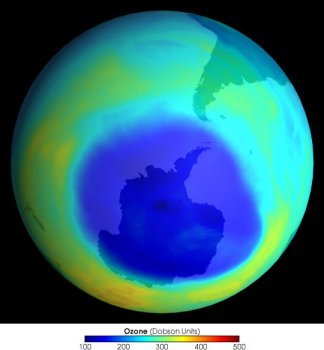
The Scientific Assessment of Ozone Depletion 2010 also provides new information about the effects of climate change on the ozone layer, as well as the impact of ozone changes on the Earth’s climate.
The report was written and reviewed by some 300 scientists and launched on Thursday during the UN International Day for the Preservation of the Ozone Layer. September 16 was chosen as the date to mark the signature date, in 1987, of the Montreal Protocol on Substances that Deplete the Ozone Layer.
The report reaffirms that the Montreal Protocol is working. “It has protected the stratospheric ozone layer from much higher levels of depletion by phasing out production and consumption of ozone depleting substances.â€
Given that many substances that deplete the ozone layer are also potent greenhouse gases, the report says that the Montreal Protocol has “provided substantial co-benefits by reducing climate change.â€
In 2010, the reduction of ozone depleting substances as a result of the Montreal Protocol, expressed in CO2-equivalent emissions (about 10 Gigatonnes per year), were five times larger than those targeted by the first commitment period (2008-2012) of the Kyoto Protocol, the greenhouse emissions reduction treaty.
The report published by the World Meteorological Organization (WMO) and the United Nations Environment Programme (UNEP) says that an important remaining scientific challenge is to project future ozone abundance based on an understanding of the complex linkages between ozone and climate change.
The report has found that global ozone and ozone in the Arctic and Antarctic regions is no longer decreasing but is not yet increasing. As a result of the phase-out of ozone depleting substances under the Montreal Protocol, the ozone layer outside the Polar regions is projected to recover to its pre-1980 levels some time before the middle of this century. The recovery might be speeded up by greenhouse gas-induced cooling of the upper stratosphere. The impact of the Antarctic ozone hole on surface climate is becoming evident, leading to important changes in surface temperature and wind patterns. It is reaffirmed that at mid-latitudes, surface UV radiation has been about constant over the last decade.
Many ozone depleting chemicals, such as CFCs (chlorofluorocarbons), once present in products such as refrigerators and spray cans, have been phased out. Demand for replacement substances called HCFCs (hydrochlorofluorocarbons) and HFCs (hydrofluorocarbons) has increased. Many of these are powerful greenhouse gases. Total emissions of HCFCs are projected to begin to decline in the coming decade due to measures agreed under the Montreal Protocol in 2007. But they are currently increasing faster than four years ago. The most abundant one, HCFC-22, increased more than 50% faster in 2007-2008 than in 2003-2004.
The Scientific Assessment Panel will present the Executive Summary of the new report at the next annual Meeting of the Parties to the Montreal Protocol, to be held in Kampala, Uganda, from 8 to 12 November 2010.
Source: UNEP





